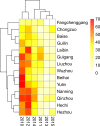Epidemiological and genetic characteristics of EV71 in hand, foot, and mouth disease in Guangxi, southern China, from 2010 to 2015
- PMID: 29216216
- PMCID: PMC5720782
- DOI: 10.1371/journal.pone.0188640
Epidemiological and genetic characteristics of EV71 in hand, foot, and mouth disease in Guangxi, southern China, from 2010 to 2015
Abstract
Hand, foot, and mouth disease (HFMD) is a significant public health challenge in China. Human enterovirus 71 (EV71) is regarded as the predominant causative pathogen of HFMD. Since 2015, two inactivated EV71 vaccines have been approved in mainland China, and because their use could change the HFMD pathogen spectrum, this should now be monitored. However, the epidemiological and genetic trends of EV71 with respect to HFMD in Guangxi, southern China, are still not clear. In this study, we describe the epidemiological and genetic characterization of this virus in clinically-diagnosed HFMD reported from 2010 to 2015 in Guangxi. Data showed that a two-year epidemic cycle, with a predominance of EV71 infections, contributed to HFMD outbreaks in Guangxi. Furthermore, this virus is a major causative agent of severe and fatal HFMD. Interestingly, in Guangxi, EV71-positive rates tended to decrease over time. In particular, EV71-positive rates were found in Fangchenggang city, which reported very few severe and fatal cases over the six-year period. Phylogenetic analysis of the VP1 gene revealed that the major circulating strains belonged exclusively to genotype C, subtype 4a (C4a), and most clustered with strains circulating in southern China. The most interesting finding was that a strain isolated in 2012 clustered with Vietnamese strains isolated from 2011-2012. The data highlight the importance of pathogen surveillance for HFMD in China, especially Guangxi, which is located on the border of China and the Association of Southeast Asian Nations.
Conflict of interest statement
Figures







References
-
- Solomon T, Lewthwaite P, Perera D, Cardosa MJ, McMinn P, Ooi MH. Virology, epidemiology, pathogenesis, and control of enterovirus 71. Lancet Infect Dis 2010;10(11):778–90. doi: 10.1016/S1473-3099(10)70194-8 - DOI - PubMed
-
- Mao Q, Wang Y, Yao X, Bian L, Wu X, Xu M, et al. Coxsackievirus A16: epidemiology, diagnosis, and vaccine. Hum Vaccin Immunother 2014;10(2):360–7. doi: 10.4161/hv.27087 - DOI - PMC - PubMed
-
- Yi L, Lu J, Kung HF, He ML. The virology and developments toward control of human enterovirus 71. Crit Rev Microbiol 2011;37(4):313–27. doi: 10.3109/1040841X.2011.580723 - DOI - PubMed
-
- Zhang X, Wang H, Ding S, Wang X, Chen X, Wo Y, et al. Prevalence of enteroviruses in children with and without hand, foot, and mouth disease in China. BMC Infect Dis 2013;13:606 doi: 10.1186/1471-2334-13-606 - DOI - PMC - PubMed
-
- Zeng H, Lu J, Zheng H, Yi L, Guo X, Liu L, et al. The Epidemiological Study of Coxsackievirus A6 revealing Hand, Foot and Mouth Disease Epidemic patterns in Guangdong, China. Scientific Reports 2015;5:10550 doi: 10.1038/srep10550 - DOI - PMC - PubMed
MeSH terms
LinkOut - more resources
Full Text Sources
Other Literature Sources
Miscellaneous

